Soledar
Soledar (Ukrainian: Соледар, IPA: [soɫeˈdɑr]; Russian: Соледар, IPA: [səlʲɪˈdar]; lit. 'gift of salt'),[1] formerly known as Karlo-Libknekhtovsk[lower-alpha 1] from 1965 to 1991, is a small city in Bakhmut Raion, Donetsk Oblast, eastern Ukraine. Situated in the industrial Donbas region, Soledar lies 18 km (11 mi) from the city of Bakhmut, and its population was 10,490 in January 2022. It is a highly important salt-mining location, with the Soledar Salt Mine providing 95% of Ukraine's salt in 2021.[2]
Soledar
Соледар | |
|---|---|
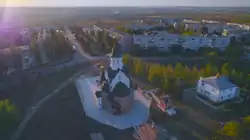 The Holy Transfiguration Church of Soledar and surrounding buildings, pictured in April 2022 | |
 Flag  Coat of arms | |
 Soledar  Soledar | |
| Coordinates: 48°41′43″N 38°04′03″E | |
| Country | |
| Oblast | |
| Raion | |
| Hromada | Soledar urban hromada |
| Foundation | Last quarter of the 17th century |
| City status | 1965 |
| Area | |
| • Total | 14.108 km2 (5.447 sq mi) |
| Elevation | 100 m (300 ft) |
| Population (January 2022) | |
| • Total | 10,490 |
| • Density | 740/km2 (1,900/sq mi) |
| Postal code | 84545–84548 |
| Area code | +380 6274 |
| KOATUU | 1420910800 |
Soledar has been almost entirely destroyed due to intense fighting during the Russian invasion of Ukraine, after which it came under Russian control on 11 January 2023.[3][4] Since then, it has been occupied by Russia as part of their Donetsk People's Republic.[5]
Geography
Natural features
_(cropped).png.webp)
There is a system of lakes on the edge of Soledar, some with a diameter of 100 metres (330 ft). Some of them have an "abnormally warm temperature" that can reach up to 40 °C (104 °F). Some are freshwater, while other parts are salty to the point that a person cannot dive deep, and gets pushed upwards.[6]
In 2021, a schoolgirl from Zhytomyr Oblast did an experiment on the properties of the lake, and concluded that it could be possible to use it for energy production.[7]
The salt extraction company Artemsil, which is based in the settlement, has said that the salt deposits of Soledar are "almost inexhaustible", and that in 300 years of exploitation, the salt reserves have only decreased by one percent.[6]
Subordinate settlements
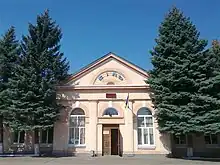
Sil (Ukrainian: Сіль; Russian: Соль, romanized: Sol, both literally translated as "Salt") is a settlement about 3 kilometres (1.9 mi) northwest of Soledar proper.[8] Formerly an urban-type settlement of its own, in 1999, the Verkhovna Rada officially declared it administratively subordinate to Soledar.[9] It is most notable for its large railway station, which serves as an essential hub station for shipping out Soledar's salt.[10]
The Dekonska (Ukrainian: Деконська) railway station is another formerly separate settlement, and is located 2 kilometres (1.2 mi) from Soledar proper,[11] in the southern outskirts of Soledar's administrative territory.[12] In 1926, its population included over 200 Volga Germans.[13]
History
Preceding settlements
During the second half of the 17th century, the Don Cossacks settled in the region of Donbas.[14] They built a village at the site of Soledar and named it Brіantsіvka (Ukrainian: Брянцівка, Russian: Брянцовка).[6] Salt mining on an industrial scale began in the settlement in 1881,[15] by which time it was part of the Russian Empire.[1] Over the following years, the scale increased, and hundreds of workers worked in the mines.[6]
Modern history
In 1925, during the Soviet period, several mining villages in the area were administratively merged into a new village, named Karlo-Libknekhtovsk[16] after the German socialist Karl Liebknecht.[17][18] During World War II, Karlo-Libnekhtovsk was occupied by Nazi Germany starting in October 1941. Soviet partisans sabotaged the mines and factories as to not let the Nazis take advantage of them. The village was eventually liberated in September 1943.[16] The salt mines were later restored and returned to functionality.[6] In 1965, Karlo-Libknekhtovsk received the status of urban-type settlement.[1]
In July 1991, Karlo-Libknekhtovsk changed its name to Soledar.[6] This name literally means "a gift of salt" in the Russian language,[1] reflecting its prominent salt-mining industry.[19] In 2000, a Ukrainian scientist proposed to use Soledar's salt mines as a nuclear waste disposal site, believing that the inert environment would be useful. Residents of Soledar and neighboring Bakhmut had a negative response to the proposal. They held rallies and wrote letters to authorities, and eventually, regional authorities said that the plan would not be implemented.[6]
War in Donbas (2014–2015)
In February 2014, removal of pro-Russian Ukrainian President Victor Yanukovych during the Ukrainian Revolution caused backlash in southern and eastern Ukraine. In mid-April 2014, local pro-Russian militias that refused to recognise the new government captured several settlements in the Donetsk Oblast (including Soledar),[20] which they wanted to separate from Ukraine as the Donetsk People's Republic. On 21 July 2014, Ukrainian forces recaptured the settlement from the militants.[20][21]
On 2 August 2014, Soledar was used as the base for the identification team and OSCE observers dealing with the MH17 plane crash due to its proximity to the site.[22][23][24]
On 14 January 2015, the body of Ivan Reznichenko was found. Reznichenko had been a deputy of the local council missing since June of the previous year, when Soledar was under the control of pro-Russia separatists. The press service of the political party Batkivshchyna said the criminals who killed him, who were now in custody, had been ordered to do so by the pro-Russian separatists.[25]
Battle of Soledar (2022–2023)
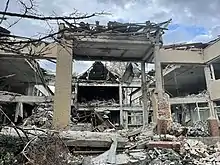
During the 2022 Russian invasion of Ukraine, on 28 May 2022, it was reported that a Russian missile had hit the Artemsil salt plant in the settlement.[26] By the end of the month, Artemsil was forced to stop production due to constant Russian shelling.[6]
The Battle of Soledar began in early August, with Russian forces capturing much of the eastern half of Soledar by September, although being stalled afterward.[27] Starting on 27 December 2022, the Russian Wagner Group began a breakthrough attempt to take the settlement and return it to the control of the Donetsk People Republic, which by then had been annexed by Russia.[28][29] The battle descended into heavy attritional fighting,[3] and was called the "most bloody battle" of the war at the time.[4] In early January 2023, after days of uncertainty as to whether Russia controlled the settlement, it was reported that Russia had definitively secured control of Soledar.[30]
By the end of the fighting, the settlement was largely destroyed, with Ukrainian President Volodymyr Zelensky saying that "barely any walls in Soledar remain[ed] standing".[31] According to Donetsk Oblast governor Pavlo Kyrylenko, of the pre-invasion population of 10,490,[32] only "559 civilians including 15 children" remained in the settlement by 13 January.[31]
Economy
Mining and processing
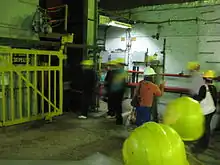
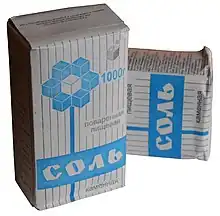
The main enterprises of the settlement are related to the mining and processing industries.[33] The state enterprise Artemsil owns the Soledar Salt Mine,[34] the largest salt mine in Europe.[35][36]
In 2021, the mine provided 95% of Ukraine's salt.[2] Outside of Ukraine, the company has exported salt to 22 countries, mostly in the former Soviet sphere.[37] Russia used to be an important export destination in particular, with it making up a third of Artemsil's market value,[38] and Artemsil having a 24% share of the Russian salt market until January 2015,[37] when Russia abruptly suspended imports from the company.[38]
There is also an abundance of gypsum that is mined, which is useful for construction materials.[39] The Germany-based company Knauf Gips Donbas owns a factory in Soledar that produces plasterboard, and has invested tens of millions of dollars into the enterprise.[40]
Salt mine tourism
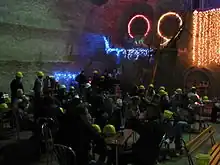
_6.jpg.webp)
Soledar's long history of mining has created an "underground city" of tunnels[41] that Deutsche Welle described as a "magnet for tourists".[42] There are guided tours as deep as 200–300 metres (660–980 ft), with attractions including sculptures made of salt crystals.[42]
In 2004 and 2006, a cave was repurposed to host classical music concerts by the Donetsk Symphony Orchestra underground.[41] In September 2020, the same chamber was also used for a soccer (football) match.[43] [41] It was also host to the first-ever underground hot air balloon flight, as listed in the Guinness Book of Records.[44]
Since the early 1990s,[44] the chambers have also contained "speleosanatoriums":[42] rooms made of salt that attempt to "recreate the allegedly restorative conditions of salt mines",[45] where 100 patients with respiratory diseases are treated.[42] This practice is part of the controversial halotherapy industry, in which it is believed that the inhalation of salt dust is a "miracle cure for respiratory illnesses".[45]Science
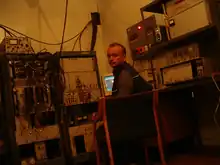
The Artyomovsk Scintillation Detector is located in Soledar.[46] Since November 1977, it has been operated in the salt mine at a depth of 570 metres (1,870 ft). Its main purpose is to detect neutrino radiation from collapsing stars.[47] This location inside the salt mine was chosen because the "natural-radioactivity background in salt is approximately 300 times lower than in ordinary rock," thus minimizing radiation noise.[46]
On 15 March 2005, the Donetsk Oblast Council gave the Institute for Nuclear Research of the Russian Academy of Sciences the right to use 0.63 hectares of area in the mine and the station for research.[48] By that time, the station had 11 employees, most of whom were citizens of Ukraine.[48]
Demographics
|
|
The settlement's population has fallen over the past few decades, from 14,600 in 1971[11] to 10,490 in 2022.[32]
Native language as of the Ukrainian Census of 2001: Ukrainian 60.10%, Russian 39.43%, Armenian 0.11%, Belarusian 0.09%, Romani 0.05%, Bulgarian 0.02%, Moldovan 0.02%, and one person each for Greek, Karaim, Polish and Romanian (0.01%).[52]
Notable people
- Horden Brova, volleyball player
- Peter N. Fedorov, astronomer
- Anna Stetsenko, Paralympic swimmer
References
- Goncharenko, Roman (11 January 2023). "Soledar would be a strategic victory for Russia". Deutsche Welle. Retrieved 23 January 2023.
- MacDonald, Alistair; Pyrozhok, Oksana. "Giant Ukrainian Salt Mine Takes Center Stage in War". The Wall Street Journal.
- Bailey, Riley; Williams, Madison; Philipson, Layne; Stepanenko, Kateryna; Barros, George; Hird, Karolina; Clark, Mason (12 January 2023). "Russian Offensive Campaign Assessment, January 12, 2023". Institute for the Study of War. Archived from the original on 13 January 2023. Retrieved 13 January 2023.
- "Why the fight for Soledar has become the "most bloody battle" of Russia's war in Ukraine". CBS News. 12 January 2023. Retrieved 13 January 2023.
- "Ukraine war: Ukraine admits pulling out of front line town of Soledar". BBC News. 19 January 2023. Retrieved 26 January 2023.
- Dorosh, Svitlana (12 January 2023). "Соледар. Цікаві факти про місто, бій за яке називають божевіллям". BBC (in Ukrainian). Retrieved 23 January 2023.
- "A schoolgirl from Zhytomyr assures that you can get energy from salt lakes". Rubryka. 28 October 2021. Retrieved 11 February 2023.
- Subramaniam, Tara; Vales, Leinz; Sangal, Aditi; Hayes, Mike; Hammond, Elise; Chowdhury, Maureen (16 January 2023). "Russian mercenary group claims to capture train station west of Soledar". CNN. Retrieved 21 January 2023.
- "Про зміну меж міста Соледар Артемівської міської ради Донецької області" [About the change of boundaries of the city of Soledar of the Artemiv city council of the Donetsk region]. Законодавство України (in Ukrainian). Archived from the original on 10 September 2018. Retrieved 15 September 2018.
- Pavlysh, Oleksii (23 May 2022). "Because of the war, Artemsil has shut down: Ukraine will have to import more salt from abroad". Ukrainska Pravda. Retrieved 21 January 2023.
Our hub station 'Sil', where we took railway trucks off the main tracks, is being shelled on a regular basis. Artemsil is mainly focused on shipping its products by rail. [...] We can ship only a small part [of our products] by road. Even under normal circumstances we have to ship the extracted salt in something [in railway cars, - Ed.], and if the railway isn't working, we simply can't do that.
- "Карло-Либкнехтовск". Great Soviet Encyclopedia.
- Bailey, Riley; Hird, Karolina; Stepanenko, Kateryna; Mappes, Grace; Williams, Madison; Philipson, Layne; Kagan, Frederick W. (4 January 2023). "Russian Offensive Campaign Assessment, January 4, 2023". Institute for the Study of War. Retrieved 11 February 2023.
Russian sources claimed that Russian forces captured three unspecified former Ukrainian defensive positions south of Soledar and seized the Deksonska [sic] railway station on the southern outskirts of Soledar.
- Diesendorf, V. "ДЕКОНСКАЯ". In Aumann, W.; Baumgärtner, V.; Brett, W.; Bugaj, N.; Ehrlich, A.; Petrov, Ju.; Tschebotarjowa, V.; Wardenburg, N. (eds.). Die Deutschen Russlands: Siedlungen und Siedlungsgebiete Lexikon (PDF) (in Russian and German).
- Katchanovski, Ivan; Kohut, Zenon E.; Nebesio, Bohdan Y.; Yurkevich, Myroslav. (2013) "Donets Basin" (Donbas), pp. 135–136 in: Historical Dictionary of Ukraine. Lanham : The Scarecrow Press, Inc. ISBN 081087847X
- Picheta, Rob; Lister, Tim; Voitovych, Olga (13 January 2023). "Why Russia is so intent on capturing the town of Soledar". CNN. Retrieved 6 February 2023.
- "Карло-Лібкнехтівськ, Артемівський район, Донецька область" (in Ukrainian). Retrieved 6 September 2023.
- "Карло-Либкнехтовск". Great Encyclopedic Dictionary.
- "Бои за Соледар: что нужно знать о пригороде Бахмута" [Battles for Soledar: what you need to know about the suburb of Bakhmut]. Deutsche Welle.
- "Ukraine frontline town just wants 'peace and silence'". France24. 7 July 2022. Retrieved 23 January 2023.
- "Ukrainian troops take control of three settlements in Donetsk region". Archived from the original on 4 June 2016. Retrieved 22 July 2014.
- Ragozin, Leonid (16 April 2014). "Vladimir Putin is Accidentally Bringing Eastern and Western Ukraine Together". The New Republic.
- "Recovery of remains 'biggest day': OSCE". Special Broadcasting Service. 2 August 2014.
- "Malaysia Airlines MH17 crash: More remains recovered from site, says Netherlands". The Straits Times. August 2014.
- "MH17 crash mission to be unarmed for now: Dutch PM". 2 August 2014.
- "Знайшли тіло вбитого сепаратистами депутата від Батьківщини". Ukrainska Pravda. 16 January 2015. Retrieved 6 February 2023.
- "Окупанти завдали удару по заводу Артемсіль" [The occupiers attacked the Artemsil plant] (in Ukrainian). 28 May 2022.
- "Russian attacks grind on in eastern Ukraine as Bakhmut is 'destroyed'". CNBC. 10 December 2022. Retrieved 4 January 2023.
- "Soledar Situation Unclear as Wagner Group's Claims of Control in Dispute". 11 January 2023. Retrieved 11 January 2023.
- "Ukraine war: Who controls Soledar and why it matters". BBC News. Department for Digital, Culture, Media and Sport. 11 January 2023. Retrieved 12 January 2023.
- "Ukraine confirms that Russia has taken control of disputed town of Soledar". MSN. Retrieved 17 January 2023.
- "Russia claims control of salt mine town Soledar". bbc.com. 13 January 2023. Retrieved 13 January 2023.
- Чисельність наявного населення України на 1 січня 2022. ukrstat.gov.ua. p. 16
- Meldrum, Andrew. "Battle rages in Ukraine town; Russia shakes up its military". Retrieved 21 January 2023.
Soledar, known for salt mining and processing, has little intrinsic value but it lies at a strategic point 10 kilometers (six miles) north of the city of Bakhmut, which Russian forces want to surround.
- "Take a look inside the incredible 'underground city' carved from salt that Russia and Ukraine are battling over".
The vast salt mines are owned by state enterprise Artemsil, which was one the biggest producers of salt in Europe, but halted operations following Russia's invasion in February.
- Balmforth, Tom; Smilianets, Vladyslav. "Russian mercenary firm claims strategic Ukrainian town of Soledar, control unclear". Retrieved 10 January 2023.
- Trofimov, Yaroslav (11 January 2023). "Russia Claims Success in Ukraine's Soledar as Moscow Names New War Commander". WSJ. Retrieved 12 January 2023.
- "Russia bans salt imports from state Ukrainian firm". Reuters. 26 January 2015. Retrieved 26 January 2023.
- Chapple, Amos (11 January 2023). "Salt of the Earth: Deep Inside Eastern Ukraine's Massive Soledar Mines". Retrieved 21 January 2023.
- Thorpe, Andrew. "Why the salt mines of Soledar, a 'network of underground cities', are prized by Russian mercenaries". Retrieved 21 January 2023.
- Eros, Igor (17 August 2006). "Knauf launching second plasterboard plant in Ukraine". Kyiv Post. Retrieved 21 January 2023.
- "Take a look inside the incredible 'underground city' carved from salt that Russia and Ukraine are battling over".
The vast salt mines are owned by state enterprise Artemsil, which was one the biggest producers of salt in Europe, but halted operations following Russia's invasion in February.
- "Бои за Соледар: что нужно знать о пригороде Бахмута" [Battles for Soledar: what you need to know about the suburb of Bakhmut]. Deutsche Welle.
- MacDonald, Alistair; Pyrozhok, Oksana. "Giant Ukrainian Salt Mine Takes Center Stage in War". The Wall Street Journal.
- Dorosh, Svitlana (12 January 2023). "Соледар. Цікаві факти про місто, бій за яке називають божевіллям". BBC (in Ukrainian). Retrieved 23 January 2023.
- Chapple, Amos (11 January 2023). "Salt of the Earth: Deep Inside Eastern Ukraine's Massive Soledar Mines". Retrieved 21 January 2023.
- Antonenko, A. G.; Borshchevsky, V. P.; Enikeev, R. I.; Ochkas, O. V.; Ryazhskaya, Olga Georgievna; Chernyshov, L. V.; Yarosh, A. P.; Iarosh, N. A. (1 January 2018). "Forty Years to the Artemovsk Scintillation Detector for Neutrinos". Physics of Atomic Nuclei. 81 (1): 88–94. Bibcode:2018PAN....81...88A. doi:10.1134/S1063778818010040. ISSN 1562-692X. S2CID 255235707. Retrieved 16 February 2023.
- Ashikhmin, V. V.; Enikeev, R. I.; Pokropivny, A. V.; Ryazhskaya, O. G.; Ryasny, V. G. (11 December 2013). "Search for neutrino radiation from collapsing stars with the Artyomovsk scintillation detector". Bulletin of the Russian Academy of Sciences: Physics. 77 (11): 1333–1335. Bibcode:2013BRASP..77.1333A. doi:10.3103/S1062873813110051. ISSN 1062-8738. S2CID 255431778.
- "GEOnews - Украина. Каменную соль Артемовска РАН будет использовать для исследований" (in Russian). Retrieved 10 September 2023.
- "Розподіл населення за рідною мовою на ukrcensus.gov.ua" [Distribution of the population by native language at ukrcensus.gov.ua]. Archived from the original on 31 July 2014. Retrieved 16 March 2014.
- "Чисельність наявного населення України на 1 січня 2013 року. Державна служба статистики України. Київ, 2013. стор.50" (PDF). Archived from the original (PDF) on 17 June 2022.
- "Ukraine forces retain control of Soledar, governor says". 14 January 2023.
- "Databank". All-Ukrainian Population Census.